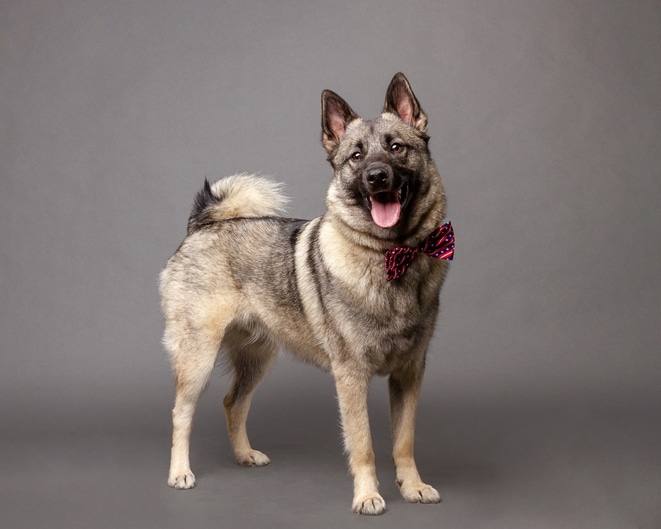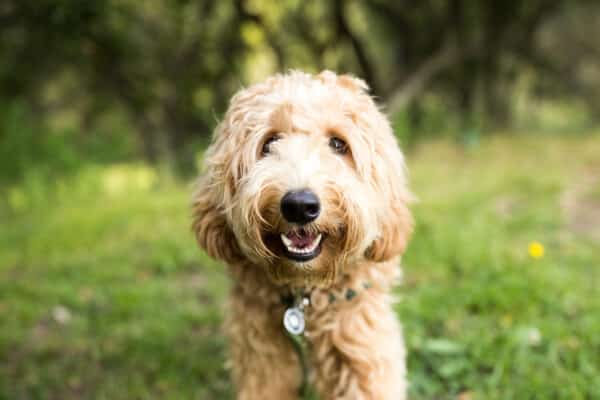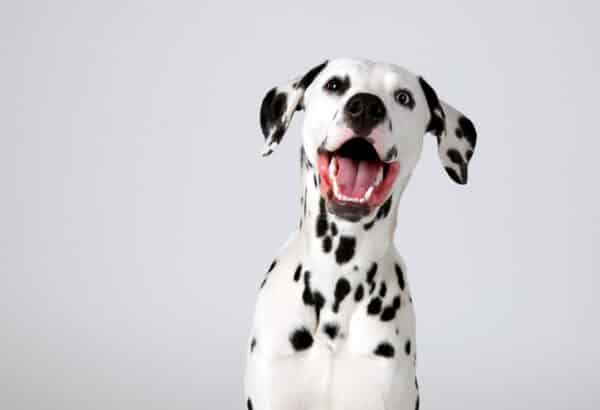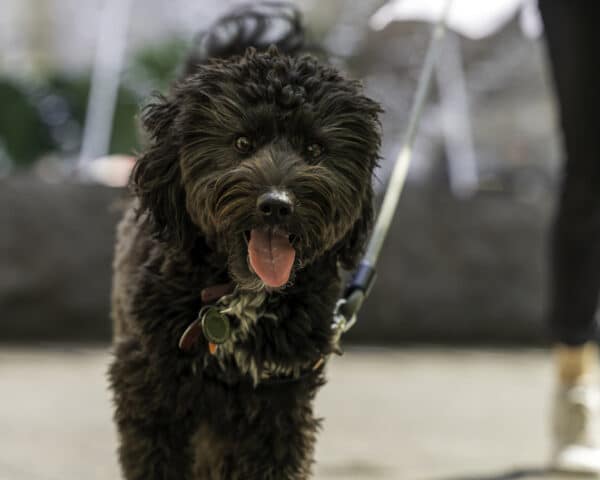Named the national dog of Norway, historians trace the Norwegian Elkhound’s origins as far back as 5,000 BC in that country. He was prized by the Vikings as a hunting companion and ably served on the farm as a guardian and herder. He demonstrated his courage in tracking and hunting moose, bears and wolves. He would keep the moose at bay, darting back and forth, distracting it, while the hunters followed the loud barking. Elkhounds typically bark only when the moose is standing still, but they can also drive the moose toward shooters lying in wait. In another style of hunting, Elkhounds are used on leash while silently pulling the hunter in the direction of the quarry. The Elkhound is considered one of the oldest European breeds and was first shown at a dog exhibition in Norway in 1877. Interest in the breed spread to England in the early 1900s. By 1930 the Norwegian Elkhound Association of America was established.
How the Norwegian Elkhound got his name
The American Kennel Club breed name is a direct translation of Norsk elghund, the original Norwegian name meaning “Norwegian moose dog.” That’s right, moose, not elk. In Medieval times, the dog breed was known as a dyrehund, meaning “animal-dog” in Norwegian. He was treasured as a hunting dog but rarely seen outside of Norway until England began taking notice of the breed.
Norwegian Elkhound appearance: Signature silver
Unlike many dog breeds that come in a variety of colors and markings, the Norwegian Elkhound always comes in silver gray. Medium gray is preferred, but variations in shade are determined by the length of the black tips and the quantity of outer coat. The undercoat is clear light silver, as are the legs, stomach and underside of the tail. The muzzle, ears and tail tip are black. Any other color is a disqualification in the show ring, according to the American Kennel Club breed standard.
Norwegian Elkhound temperament: Smart but stubborn
Lovers of the Norwegian Elkhound dog rave about his friendly, confident, dependable temperament, but as a member in good standing of the hunting Nordic Spitz family, there is a big dollop of independence to deal with as well. Elkhounds learn quickly, but the stubborn streak runs deep. They won’t follow instructions without some resistance.
Norwegian Elkhound puppy
When training a Norwegian Elkhound puppy:
- use positive reinforcement
- reward generously with treats
- keep the sessions short and entertaining to prevent boredom.
- Teach Norwegian Elkhound puppies to heel from an early age as the breed is prone to pulling on leash.
- True to their Nordic Spitz ancestry, Elkhounds are barkers with boundless energy, so be prepared to channel all that loud, get-up-and-go in positive ways.
Norwegian Elkhound size
The Norwegian Elkhound is medium-sized dog breed. Males stand 20.5 inches high at the withers; females 19.5 inches at the withers. Males weigh approximately 55 pounds; females 48 pounds.
Norwegian Elkhound in the White House
The most famous Elkhound outside of Norway was Weegie, President Herbert Hoover’s companion while he was in the White House in the 1930s. The distinctive silver-gray dog definitely raised interest in the breed during those early days.
Norwegian Elkhound lifespan
The Norwegian Elkhound is a sturdy dog that can enjoy a long, active life. They have a typical lifespan of 12 to 16 years, and some have lived to 18 years or more. They can put on weight easily, so it’s best to keep them fit and trim.
- Where does the Norwegian Elkhound come from?
Norway. He is one of the oldest European breeds, is a member of the Nordic Spitz family and is the National Dog of Norway.
- How did the Norwegian Elkhound get his name?
The name is a direct translation from the original Norwegian name Norsk elghund, which means “Norwegian moose dog.” That’s right, moose, not elk.
- What is the Norwegian Elkhound like?
Friendly, confident, dependable, affectionate. Stubborn and independent. Reserved with strangers until properly introduced.
- How active is the Norwegian Elkhound?
Very. This is a hunter, tracker and top-performing athlete so frequent, vigorous exercise is a must, as well as interactive games and play.
- Is the Norwegian Elkhound good at any dog sports or activities?
Yes. This is a smart and versatile breed. Agility, flyball, carting and herding are all great dog sports to channel the Elkhound’s energy. They are also fine swimmers.
- Does the Norwegian Elkhound need a job?
Yes. Elkhounds are versatile and adaptable. Work around their stubborn streak, be inventive, and make them think the job was their idea.
- Is the Norwegian Elkhound good for first-time dog owners?
They can be. They are smart but independent, so training will be a challenge. Don’t expect a push-button dog. They are also vocal, so accept that you will have to control that barking tendency from a young age. Here are some tips on controlling a dog bark.
- Is the Norwegian Elkhound a good family pet?
The best match would be active owners and families that enjoy exercise and have a fenced yard. This is a strong, boisterous dog breed with a tendency to pull on the leash so exercising by a young child or a senior probably not advised. The Norwegian Elkhound is bred to hunt, so watch the rodents, pet birds and cats. The breed likes to bark so not ideal for renters, or those who are away for long periods of time.
- Is the Norwegian Elkhound a good apartment dog?
Typically, no. A large, securely fenced yard is recommended for safe, off-leash exercise. This is a high-energy dog who can become destructive if suitable outlets are not provided.
- How easy is it to train a Norwegian Elkhound?
The dog breed is trainable but given his independence, lessons should be short, fun and varied. Mental stimulation is key to prevent boredom. Read out article on basic, or manners training, your dog.
- Is the Norwegian Elkhound given to excessive barking?
Yes. This is a typical Nordic Spitz so he will be vocal. You will need to train your Elkhound puppy from an early age that random barking is not acceptable. Barking is often a sign of boredom so keep his environment interesting.
- Does the Norwegian Elkhound make a good traveler?
Typically, yes. Get him accustomed to car travel early. Crate training is essential for safe car and air travel, hotel and motel stays, overnight visits to the veterinarian, etc.
- Is the Norwegian Elkhound easy to groom?
Yes, in terms of not requiring visits to a professional groomer for trimming. However, the breed has a thick, double coat so there is lots of shedding year-round. Frequent, thorough brushing will remove a lot of that dead hair before it ends up on your floors, carpets, furniture and clothes. In his favor, the Elkhound coat does not carry a doggy smell, and so baths are not frequently needed. Regular care of nails, ears and anal glands is necessary, as with every dog.
- How popular is the Norwegian Elkhound?
No. 100 in the American Kennel Club list of most popular breeds in 2021, based on annual registrations. (There are 200 AKC-recognized breeds in all.)





